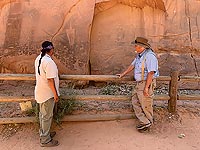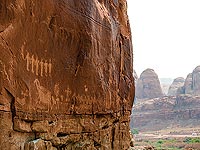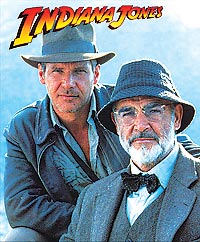by Moab Museum Staff
 |
| Bertram Tsavadawa (left) and Don Montoya (right) observing the petroglyphs at Moonflower Canyon near Moab. Their interpretations of four prominent petroglyph panels can be found in a video, upcoming live program, and Moab Museum exhibit coordinated by the Utah Humanities Council. (Photo: Moab Museum) |
“There’s a lot of connection that people feel when they come and visit these sites,” explained Bertram Tsavadawa, standing alongside a petroglyph panel in the shade of a large cottonwood at Moonflower Canyon. Tsavadawa, a Hopi guide, belongs to the corn clan from the village of Old Oraibi, 3rd Mesa in Arizona. He joined Don Montoya, a retired archeologist, and the Moab Museum to interpret four prominent petroglyph panels along the Colorado River near Moab this summer in a recorded conversation coordinated and sponsored by the Utah Humanities Council. Both visitors to Moab and locals alike often ask about the meanings behind prominent petroglyph panels, which often include rock imagery spanning thousands of years and feature images from numerous distinct cultures. The video generated from this conversation offers answers and explanations, as well as information about the importance of stewardship of these sites from both an archeological and Indigenous perspective.
Montoya and Tsavadawa offered complementary interpretations, two lenses through which to view some of Moab’s most iconic and frequently visited petroglyphs. “From an archeological perspective, what we have is imagery through time,” explained Montoya, gesturing to specific petroglyphs on the Birthing Rock Panel. “The earliest indications that we have are from what we call the Archaic period. The Archaic imagery is evidenced by a lot of curvature, a lot of abstract elements.”
“There’s always variations of understanding of how sites [were] used by Ancestors,” added Tsavadawa at another location, acknowledging that we don’t know the meanings behind every rock imagery site, and that some may hold special significance that is specific and private for Native descendants.
Four prominent, widely-visited petroglyph sites were visited as part of this project: Moonflower Canyon, Birthing Rock, Wall Street, and Poison Spider Mesa. Due to 2021 vandalism of Birthing Rock and bolting of another petroglyph panel near Moab by a rock climber, this exhibit, conversation, and video project offers a timely reminder of the importance of these sites to living communities.
 |
| Petroglyphs at the Poison Spider panel on Potash Road are among those recently interpreted in a Utah Humanities Council video featuring Hopi guide Bertram Tsavadawa and archeologist Don Montoya. (Photo: Nathaniel Clark) |
“Welcoming interpretations from both archeologists and descendants of Ancestral Native Americans allows for a more complete and accurate understanding of rock imagery sites,” says Moab Museum Curatorial & Collections Manager Tara Beresh. This project, which has generated a video accessible via moabmuseum.org the Museum’s website, a temporary exhibit at the Museum, and an upcoming online event on September 28th, was sponsored by the Utah Humanities Council as part of their Humanities in the Wild series of projects.
The September 28th online event, to be held on Zoom and simulcast on Facebook Live, will feature a live conversation between Tsavadawa, Montoya, and the Utah Humanities Council facilitated by the Moab Museum about this project, and offer a chance for audience members to contribute questions about petroglyph interpretations, stewardship, and more. For more information about this project, including information about accessing the live event, or scheduling a visit to the Moab Museum’s exhibition, can be found at moabmuseum.org.
The Museum is open Tuesday through Saturday from noon to 8:00 pm during the summer months. Visit the website for more information, and consider becoming a member. When you join the Moab Museum at any membership level, you directly support the preservation of the region’s cultural and natural history as well as youth education programs. Members empower the Moab Museum to grow, inspire, and serve the community now and for future generations.
118 East Center Street, Moab — 435-259-7985 — moabmuseum.org
 Red Cliffs Lodge, on the banks of the mighty Colorado River, is home to the Moab Museum of Film & Western Heritage. The lodge is built on the old George White Ranch, a key location for nine of the big westerns including Rio Grande, Cheyenne Autumn, Ten Who Dared, The Commancheros, and Rio Conchos.
Red Cliffs Lodge, on the banks of the mighty Colorado River, is home to the Moab Museum of Film & Western Heritage. The lodge is built on the old George White Ranch, a key location for nine of the big westerns including Rio Grande, Cheyenne Autumn, Ten Who Dared, The Commancheros, and Rio Conchos.
The late George White was founder of the Moab to Monument Valley Film Commission, the longest ongoing film commission in the world.
In the museum one can learn more about film locations, how the sets are built, and how the filming process is managed on nature’s own sound stage. On display in the museum are production photographs, movie posters, autographed scripts, props from the many pictures filmed in the area, and displays about the western ranching heritage. For information, call Red Cliffs Lodge at 435-259-2002.
 Through the magnificent landscapes of southeastern Utah, writers have been inspired and stories born here. Zane Grey, the famous western novelist, traveled through the area in 1912. His visit inspired him to write his book Riders of the Purple Sage. The book was made into a movie starring Ed Harris and Amy Madigan, and filmed on locations around Moab.
Through the magnificent landscapes of southeastern Utah, writers have been inspired and stories born here. Zane Grey, the famous western novelist, traveled through the area in 1912. His visit inspired him to write his book Riders of the Purple Sage. The book was made into a movie starring Ed Harris and Amy Madigan, and filmed on locations around Moab.
| A partial list of stars that have made movies in Moab John Wayne, Maureen O'Hara, Henry Fonda, Lee Marvin, Rock Hudson, Jimmy Stewart, Richard Boone, Anthony Quinn, Mickey Rooney, Shirley Temple, Kris Kristofferson, Billy Crystal, Robert Duvall, Gene Hackman, Bill Murray, Jack Palance, Susan Sarandon, Geena Davis, Ted Danson, Tom Cruise, and many more. |